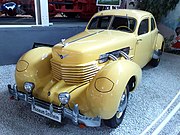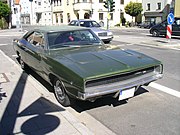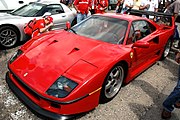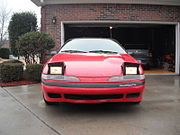
Hidden headlamps, also commonly known as pop-up headlamps, pop-up headlights, flip-eye headlamps, or hideaway headlights, are a form of automotive lighting and an automotive styling feature that conceals an automobile's headlamps when they are not in use.
Depending on the design, the headlamps may be mounted in a housing that rotates so as to sit flush with the front end as on the Lamborghini Miura or Porsche 928, may retract into the hood and/or fenders as on the 1963–2004 Chevrolet Corvette, or may be concealed behind retractable or rotating grille panels as on the 1966-1970 Dodge Charger, 1970-1971 Mercury Cyclone, or the 1965 Buick Riviera.
History

Hidden headlamps first appeared on the Cord 810 in November 1935 at the New York Auto Show and shortly after on a custom example of the Alfa Romeo 8C in 1936. In the Cord, a pair of cranks on either side of the dashboard could be turned by hand to bring out the headlamps when needed. Powered hidden headlamps first appeared on GM's concept car in 1938, the Buick Y-Job, and appeared on concept cars for several years after, including the 1951 General Motors Le Sabre. However, power hidden headlamps would not appear on a production vehicle until 1962 with the Lotus Elan. The popularity of this feature has waxed and waned over time. Hidden headlamps regained popularity in the mid-to-late 1960s, first in Europe but particularly in the US where aerodynamic headlamps were not permitted. A relatively large variety of cars incorporated hidden headlamps in the 1970s, 1980s, 1990s, and up to the early 2000s. Subsequent legislation led to hidden headlamps falling increasingly out of favor.
In the past, manufacturers often used hidden headlamps to circumvent headlight height regulations in the United States. For instance, in 1983, Toyota exported their retractable headlight version of the AE86 (known domestically as the Sprinter Trueno) instead of the Corolla Levin, as the former had a higher headlamp height, enough to satisfy US regulations. This prevented them from needing to raise the body height of the car, which would have affected handling.
Discontinuation
US laws now permit aerodynamic headlamps, relative to which hidden headlamps represent added cost, weight, and complexity as well as reliability concerns as cars age. Internationalized ECE auto safety regulations have also recently incorporated pedestrian-protection provisions restricting protuberances from car bodies, making it more difficult and expensive to design compliant pop-up headlamps.
The last time pop-up headlamps appeared on a volume-production car was in 2004, when both the Lotus Esprit and Chevrolet Corvette (C5) ended production. Development of both projector beam headlamps such as those on the 1990 Nissan 300ZX (Z32), and more efficient, bright LED headlamps has in practice, eliminated the need for hidden headlamps altogether.
Despite new cars no longer offering hidden headlamps since 2004, hidden headlamps are not outright banned, and as such, they can be still be installed on vehicles today such as the Ares Design Project1.
List of cars with hidden headlamps
Further information: List of vehicles with hidden headlampsOther vehicles with hidden headlamps
Although most hidden headlamps are installed on cars, they have also been installed on other types of vehicles. These include motorcycles such as the Honda Elite 150, some coaches such as Pegaso-Obradors and trains such as the Keisei AE100.
Gallery
-
 1937 Cord 812
1937 Cord 812
-
1938 Buick Y-Job
-
 1942 DeSoto
1942 DeSoto
-
 1967 Ford Thunderbird
1967 Ford Thunderbird
-
 1968 Chevrolet Caprice coupe
1968 Chevrolet Caprice coupe
-
 1968 Dodge Charger RT
1968 Dodge Charger RT
-
 1970 Škoda 1100 GT
1970 Škoda 1100 GT
-
1972 Opel GT
-
 1973 SAAB Sonett III
1973 SAAB Sonett III
-
 1978 BMW M1
1978 BMW M1
-
 1986 Toyota MR2
1986 Toyota MR2
-
 1987 Ferrari F40
1987 Ferrari F40
-
 1989 Mazda 323F
1989 Mazda 323F
-
 1990 Plymouth Laser
1990 Plymouth Laser
-
1991 Tatra MTX V8
-
 1992 Volvo 480
1992 Volvo 480
-
 1995 Lotus Esprit
1995 Lotus Esprit
-
 2004 Chevrolet Corvette
2004 Chevrolet Corvette
See also
References
- "1936 Cord 810 Westchester". Heritage Museums and Gardens.
- "Alfa Roméo Type 8C 2, 31". CITÉ DE L'AUTOMOBILE. Archived from the original on 2021-10-01. Retrieved 2021-10-01.
- US Patent 2084120A, Harold T Ames, "Headlight structure", issued 1937-06-15
- Mroz, Albert. "Why the 'Y-Job' -- Harley Earl and the Buick Dream Car". Pre War Buick.
- "Pop-Up Headlights – Seventy Years of Hidden History". Heacock Classic. 29 January 2019.
- Lotus Elan Owners Workshop Manual 1962-1974. Brooklands Books Ltd. 23 February 2005. p. 107. ISBN 9781855200227.
- "Code of Federal Regulations, Title 49 - Transportation". Gov Info. Table II. 2004-10-01.
- "Esprit Production Figures". Lotus Esprit World.
- "2004 C5 Corvette Production". C5 Registry.
- Perez, Jeff. "Ares Panther Is A Proper 641-HP Tribute To The Pantera". Motor1.
- "First two-wheeled vehicle with retractable headlights". Honda Japan. 1983-03-07.
External links
 Media related to Hidden headlamps at Wikimedia Commons
Media related to Hidden headlamps at Wikimedia Commons
| Automotive design | |||||||||||||
|---|---|---|---|---|---|---|---|---|---|---|---|---|---|
| Part of a series of articles on cars | |||||||||||||
| Body |
| ||||||||||||
| Exterior equipment |
| ||||||||||||
| Lighting | |||||||||||||
|---|---|---|---|---|---|---|---|---|---|---|---|---|---|
| Concepts | |||||||||||||
| Methods of generation |
| ||||||||||||
| Stationary | |||||||||||||
| Portable | |||||||||||||
| Automotive | |||||||||||||
| |||||||||||||
| |||||||||||||
| |||||||||||||
| Related topics | |||||||||||||


